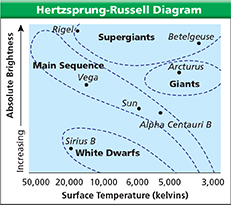Critical Thinking
Applying Concepts Two stars are the same color, but one looks much brighter in the sky. Give two possible explanations for the difference in apparent brightness.
Inferring Explain why a cool star with a high absolute brightness must be a giant or a supergiant.
Inferring Arrange the following in order of increasing density: neutron star, main-sequence star, red giant, and black hole.
Comparing and Contrasting Compare and contrast star clusters and galaxies.
Inferring Astronomers have observed that quasars have huge red shifts. What does this indicate about the distance and speed of quasars?
Math Skills
Use the diagram below to answer Questions 27–29.

Using Graphs Which star is brighter, Vega or Betelgeuse?
Using Graphs Which stars have higher surface temperatures than the sun?
Predicting Which star is likely to last the longest on the main sequence? Explain.
Calculating Vega, a star in the constellation Lyra, is located about 25 light-years from Earth. How many kilometers is this?
Calculating Another unit used by astronomers for measuring distances in space is the parsec (1 parsec is 3.26 light-years). The Andromeda Galaxy is about 890,000 parsecs from our own galaxy. How many light-years is this? How does this distance compare to the diameter of the Milky Way?
Concepts in Action
Applying Concepts How can we learn about the lives of stars, given that stars last much longer than human beings live?
Relating Cause and Effect How have supernovas made life on Earth possible?
Making Generalizations Give directions for traveling to Earth for an alien coming from the Virgo Cluster.
Inferring If astronomers cannot see dark matter, how do they know it exists?
Applying Concepts How old is the universe and how do we know?
Writing in Science Write a paragraph explaining how astronomers are able to measure the distance to other galaxies using observations of Cepheid variables.
Performance-Based Assessment
Using Models Construct a cutaway model of the sun. Use different colors of paper or clay to represent each layer of the sun's interior and atmosphere. Label each layer and include a brief description of each.





